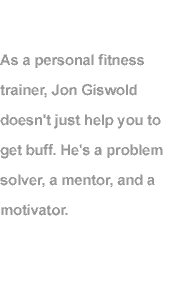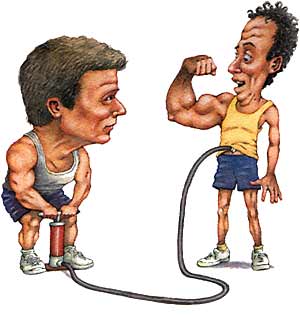 |
|
||||||||||||

|
|
|
By Arthur Boehm
|
Jon Giswold grins as he describes his most challenging assignment. "A client wanted me to make him taller," he says. "I looked at him and thought, 'Yeah, I can do it.'" The client, an artist, was 48 and certain he'd die young, as his father had, of heart disease. The guy skulked around, bent by worry and self-doubt. "He's a quarter-inch taller now," says Jon, who helped his client fix his posture and befriend his body. "He's no longer afraid of dying, because he trusts his body to function better. People think all trainers do is help make you buff, but we wear many hats. We're problem solvers, mentors, and guides. If you can't see people and motivate them to achieve their true goals -- well, maybe you're not a trainer at all." By these lights Jon is. His 12-year run in a field in which many compete but few practice competently (or for long) reflects his ability to work effectively with others while sidestepping the pitfalls of the freelance life. And, as with any thriving practice, the business has evolved. "I started as a group fitness instructor," he says, "working as an independent contractor for Equinox and Molly Fox Studios. I'm in Manhattan now, but I'm a farm boy from Minneapolis who grew up loving sports of all kinds, with a certification from the Association Council of Exercise." Within two years, Jon consolidated his strengths, quit a side-job in clothing sales, and established himself as a one-to-one trainer. Today he sees as many as 14 clients two to three times a week at a gym or in their homes.
"I began with a couple of women who wanted to bring their husbands and who, eventually, gave me to them to train, as a gift. I worked with each for six years. I'm sometimes the beneficiary of divorce -- I begin with a husband and wife, they split, and I end up with four clients in all." Jon trains people of all ages. "I work with basically three generations," he says, "each with its own needs. The 20-year-olds want to gain muscle, to look like an Abercrombie & Fitch ad. The middle-aged group wants better aerobic endurance, to maintain ideal body weight. My older clients have their own special requirements. One client of mine who's 80 wants to be able to continue to play golf -- he needs to maintain muscle and keep flexibility. He'll show up for our sessions in a typhoon, which I love. If he can show up, so can I." Selling, Celebs, Symbiosis All types of people call upon Jon's services -- there's a literary agent, a land developer, and a news-radio entertainment reporter, among others. And celebrities. "Well," says Jon, "I've trained Lucie Arnaz and Mercedes Ruehl one-to-one, and over the years I've instructed Harry Connick, Jr., Wayne Gretzky, and Luther Vandross. But I like to think of all my clients as celebrities," he says, tongue only partly in cheek. How does he find them? "You've heard it before," he says, "but the main way I get clients is word-of mouth. Your [other] clients are your best advertisement. "But I sell myself, too -- in social settings, mostly. Someone will say, 'You look good -- do you train?' or 'My butt is on the floor...' and you just jump in. Other promotional tactics include a personal Web site and a book, Basic Training, which is going into paperback this fall. A second book is in the works. He's also helped create exercise technology for Schwinn Company, the bicycle makers, and done an instructional video that had him jumping rope, all day, in Grand Central Station.
Naturally, the trainer also trains himself. He travels to conventions of fitness instructors, attends seminars, and monitors relevant Web sites for the latest training information. He works with his own trainer, too. "I want to become more flexible," he says, "so I do yoga and take stretching classes." One area in which Jon wishes he were more expert is financial management. "Taking care of medical insurance, paying quarterly taxes -- I'm just not good at it. But I have an accountant who is. I hire him to take care of me just as others hire me to take care of them." And clients sometimes return the favor. "I get business advice from my land developer," Jon says, noting further that his new literary agent is a client. Rigorous Workout But keeping up the pace isn't always easy. "It can be tough," Jon says, "so I've learned to help myself. I channel my own motivational skills and use them on me. And I change the 'program' for me as I do for my clients. Also, I like to work. I try to take on new projects, even if I'm dubious about them at first. There are lots of trainers out there, so you have to keep trying things." Trying things is at the root of Jon's method, which relies on an intuitive sense of a client's moment-to-moment needs, and the ability to adapt a session to those requirements. Take his work with Joy Santlofer, a 40-ish university researcher whose goals include weight loss and getting stronger. They've trained together for seven years and both agree that Joy has made great progress. "I would see myself in the mirror," says Joy, "all hunched over. No more. I'm stronger and my body reflects that."
Their session at a midtown gym begins with a treadmill warmup, and also involves stretching and weight work; among other exercises, Joy will do leg and bench presses and, finally, abdominal strengthening. Throughout their session Jon watches Joy like a hawk, telling her the purpose of each maneuver, trying to draw from her precisely what's going on in her body and head. "Do you feel this across your chest?" he asks Joy as she does her presses; later, "What's happening in your shins -- any pain?" while she stretches a leg; then, "Rotate your shoulders back so you get a good shrug" as she lifts a heavily weighted bar. He goads and encourages. "You really have to commit yourself to this," he says as Joy lifts a heavier load. "Give yourself enough oxygen -- take your time, don't race." Jon adjusts the weight as Joy does lateral pull-downs. "Did it feel light?" he asks. "Not light..." she says, "but not a killer, either." It's clear that Jon and Joy have a real relationship -- they have fun together. "I promise you I'm not going to talk about your weight today," he tells her at one point. "Oh, right," she says, her eyes rolling. "I gab with Joy to keep her from thinking about what hurts," Jon says. "I gab with him to keep him from working me," says Joy. "And," she adds, "we celebrate every training victory. I can't imagine working with a trainer you didn't really like." "I'm a catalyst for change," Jon says. And Joy, panting, nods. |
||||||||||||||||
|
April 24, 2000 Primary Editor: Eric Gershon Illustrator: Todd Bonita Production: Fletcher Moore |
We'd love to hear your comments about this article! Arthur Boehm is a freelance writer who lives in New York, NY. If you like, we'd be happy to put you in touch with him, or with anyone named in this article. | ||||||||||||||||
|
| |||||||||||||||||
